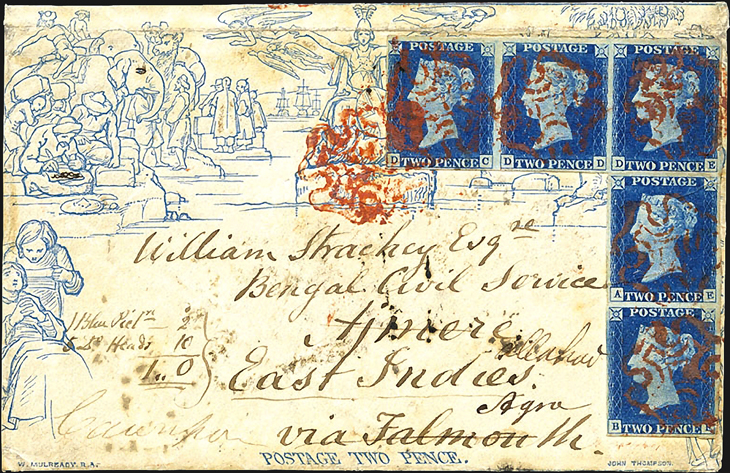Auctions
‘Lady Louis’ Mulready cover realizes $94,000 in Feldman sale
By Matthew Healey, New York Correspondent
David Feldman in Geneva offered a sale of British Empire on Dec. 11 that included the second part of the Tatiana collection, with some famous gems as well as humbler items that simply tell a great story.
Standing out was one of the most famous and spectacular pieces of British postal history in existence.
Like many budding collectors, I remember as a child browsing through my father’s coffee-table books about philately and reading about the famous “Lady Louis” cover: a 1-penny Mulready envelope uprated with five Penny Blacks and three Two-Penny Blues, addressed to Lady Louis, Malta, via Falmouth, and posted in 1841 from Bristol to Malta.
It is easy to admire the cover as a quaint relic of a lost world, from its finely engraved adhesives and the charming, almost cartoonish design on the envelope, to the toning of the paper to the quill-pen handwriting and delightfully minimalist address — just a surname and a country. It is an artifact that could never be replicated in our modern era.
Connect with Linn's Stamp News:
Like us on Facebook
Follow us on Twitter
Keep up with us on Instagram
The cover also can be appreciated as a work of art, or rather, several works of art in one.
It is a marvelous mixed-media collage, elegant in its asymmetry, incorporating fine intaglio engraving, pen-and-ink drawing, calligraphy and the energetic application of several vivid, orange-red Maltese Cross cancellations defacing each of the stamps, with one more strike at left for good measure.
On top of all this, the cover is a rarity, for it also represents a rather intriguing failure of vision.
Sir Rowland Hill, for all his genius in devising a revolutionary system of using adhesive stamps to prepay postage — a system that would launch Britain and the entire world into the modern era with cheap and speedy long-distance communication — somehow failed, at the outset, to give his scheme the one thing it needed to work globally: a stamp worth more than 2 pence.
A letter from England to the British colony at Malta, in the middle of the Mediterranean, cost a full shilling, and anyone wishing to send an epistle prepaid — not yet required, but fast becoming the social norm — had no choice but to smother the envelope with stamps.
Britain would not issue its first 1-shilling stamp until 1847.
Even then, the first such adhesive turned out to be a cumbersome, octagonal affair, manually embossed one-by-one on the same kind of equipment used to apply raised seals on important documents.
It would be several more years before a correspondent in Britain could prepay the relatively high postage on a worldwide letter as handily as on a domestic one.
As a result, the majority of overseas letters in the early 1840s continued to be either prepaid in cash or sent unpaid.
Only 50 or so Mulready envelopes and lettersheets (Scott U1-U4) are recorded sent abroad, and only a dozen of these are uprated with a 1d black (Scott 1) or 2d blue (2).
The Lady Louis cover, “one of the great covers of British philately and a superb exhibition item,” sold for £66,000, or about $94,000, including the 20 percent buyer’s premium Feldman adds to all lots.
The next lot in the sale was a similar cover: a 2d Mulready, uprated with five 2d blues and sent to India in September 1840.
Both this and the Lady Louis cover previously belonged to numerous famous collectors, including William H. Gross.
The India cover sold for £44,000 (about $75,000).
MORE RELATED ARTICLES
Headlines
-
US Stamps
Oct 7, 2024, 3 PMMcMurtrie dismissed as APS education director following Sept. 21 arrest
-
US Stamps
Oct 7, 2024, 12 PMVasiliauskas named president of Mystic Stamp Co.
-
US Stamps
Oct 6, 2024, 5 PMApgar souvenir card available
-
US Stamps
Oct 6, 2024, 4 PMFirst Continental Congress and U.N. stamps receive Scott catalog numbers







